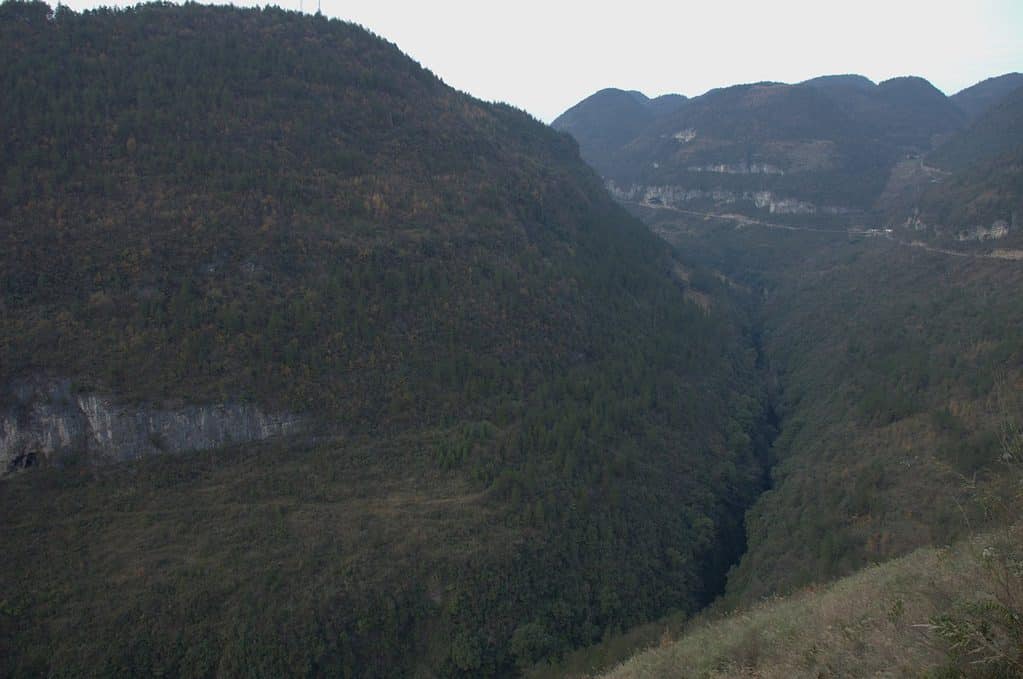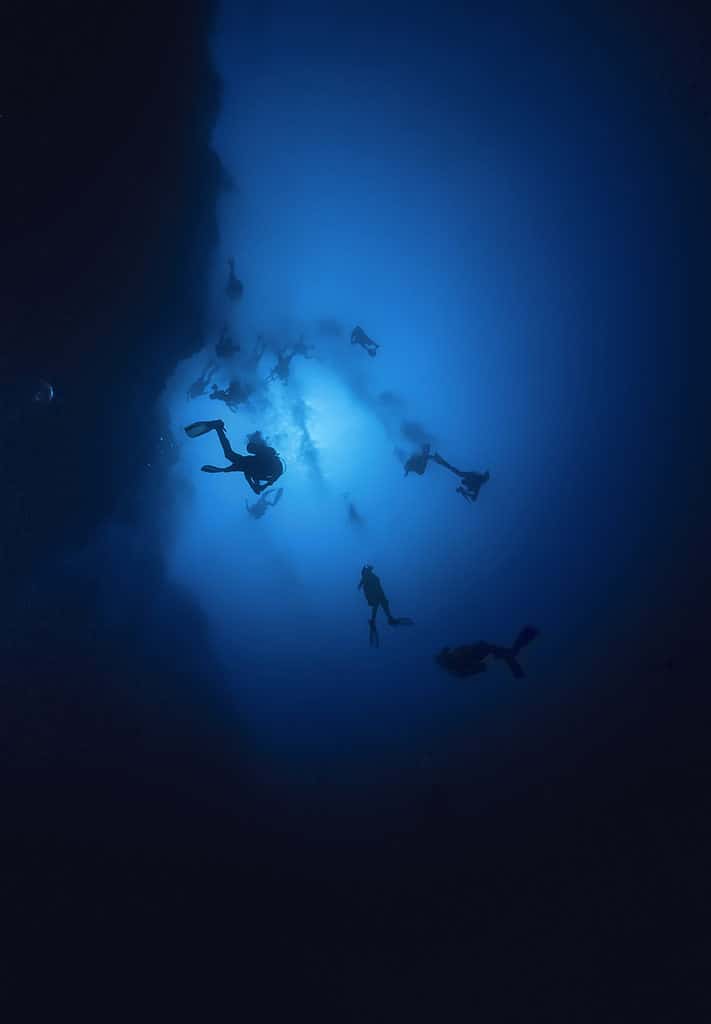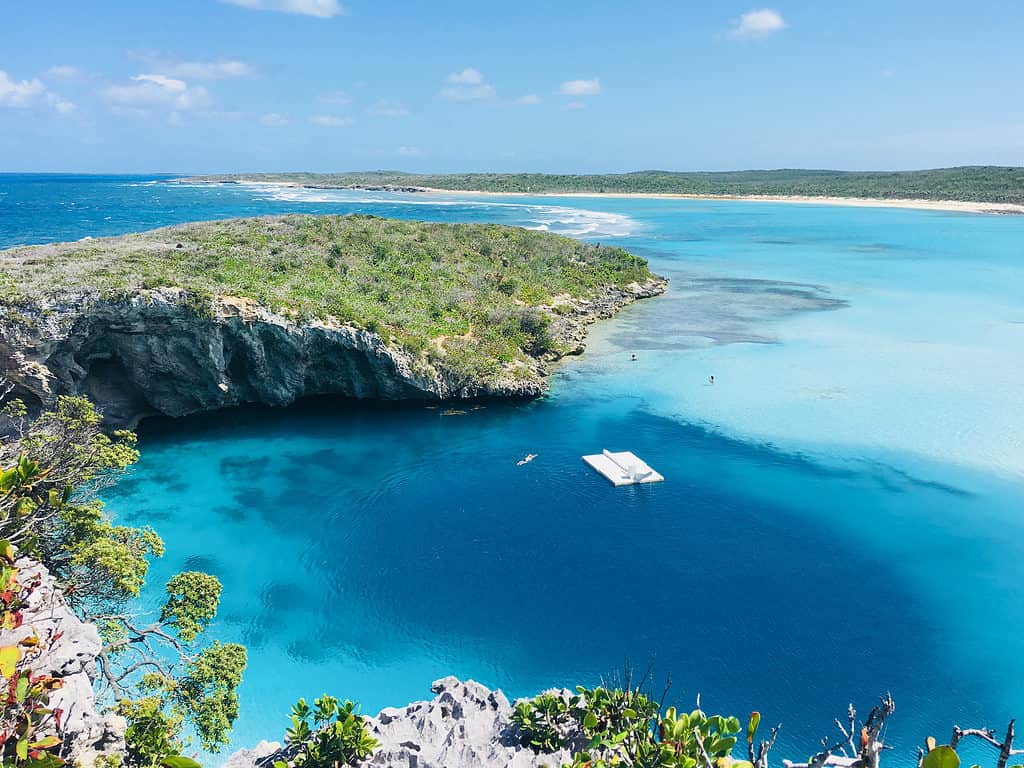Sinkholes are wonders of nature found in different parts of the world. As an explorer, you will encounter many sinkholes, each with its uniqueness. Some are dirt-filled basins, while others have water bodies or entire forests underneath the surface.
While sinkholes are awe-inspiring, they are risky and can cause extensive damage if they occur in built areas. They are also known to claim lives, with many reported deaths in the USA and around the world.
In your quest to quench your curiosity, you may want to know the largest sinkhole in the world, a credit taken by Xiaozhai Tiankeng in China.
Read on to learn more about this physical feature and honorable mentions around the world.

At more than 2000 feet long, 1762 feet wide, and almost 2200 feet deep, Xiaozhai Tiankeng is the largest sinkhole in the world.
©1,519 × 1,007 pixels, file size: 193 KB, MIME type: image/jpeg – License
Xiaozhai Tiankeng: The Largest Sinkhole in the World
At more than 2000 feet long, 1762 feet wide, and almost 2200 feet deep, Xiaozhai Tiankeng is the largest sinkhole in the world.
Locally known as the Xiaozhai Heavenly Pit, it is part of the Shaanxi Cluster, a collection of karst sinkholes in China’s Shaanxi Province.
Xiaozhai Tiankeng is a double-nested doline consisting of two bowls, giving it a unique appearance. The upper bowl is around 1050 deep while the other is 1122 feet deep. A sloping ridge separates the two sections.
While the locals knew about this feature for ages, the outside world learned about it in 1994 after its discovery by British explorers. The explorers made several attempts to survey its underground cave system but were unsuccessful. They found the sinkhole’s torrent difficult to navigate. Consequently, Xiaozhai Tiakeng remains a geological mystery to date.
Xiaozhai, which means “a little village,” is the name of a nearby abandoned village, while Tiankeng means “a heavenly pit.” Besides, the Chinese generally refer to sinkholes as heavenly pits.
This sinkhole developed over the Dinfeng Cave, which came about due to the activity of an underground river, which still runs in the sinkhole.
The Significance of the Xiaozhai Tiankeng
This doline is economically significant, as it is a major tourist attraction. Several adventure-seekers visit the sinkhole to experience its wonders.
A 2800-step staircase makes touring easier. In addition, you can spot a waterfall at the sinkhole’s mouth, particularly during the rainy season.
Many researchers tour this imposing physical feature to study it, mainly focusing on flora and fauna.
Regarding living things, this sinkhole is home to more than 1280 plant species, including the Paris polyphylla, Chinese Yew, and ginkgo. In addition, the clouded leopard, the Chinese cobra, and the Chinese giant salamander are some animals inhabiting the sinkhole.
Visiting Xiaozhai Tiankeng
Visiting the Xiaozhai Heavenly Pit as an avid adventurer should be on your bucket list. Spring is the best time for your exploration when the ecosystem is vibrant with plant life. Autumn is also perfect, with the varying plant colors being a sight to behold.
You can explore the sinkhole solo, but you will need a guide to lead you through. Alternatively, you can join the many hiking parties, where you might make new friends as you quench your curiosity about this doline.
Where is Xiaozhai Tiankeng on a Map?
While China is a massive country in size, Xiaozhai Tiankeng is located close to the center of it. It is a 16-hour drive from Beijing, China, to reach it. If you are coming south from Hanoi, Vietnam, it will take over 20 hours in the car to reach it.
How Do Sinkholes Form?
Now that we know the largest sinkhole in the world, it is prudent to understand how they came to be.
Sinkholes form due to the dissolving of the surface rock, which is mostly limestone, via karst processes. When the rock dissolves, it results in a weakened topographical structure, which will collapse and form a hole.
Sinkholes may also form due to human activities, mostly mining. For example, it is common in abandoned mines, which collapse due to a weakened structure. In addition, broken water and sewer lines can cause depressions due to the erosive action of water.

Sinkholes form due to the dissolving of the surface rock, which is mostly limestone, via karst processes.
©Poliorketes/Shutterstock.com
Types of Sinkholes
There are three types of sinkholes, categorized according to formation. The sinkholes include:
- Dissolution
- Cover-collapse
- Cover-subsidence
Dissolution Sinkholes
Dissolution sinkholes develop due to insufficient ground cover over the rock surface. As water penetrates the holes in the bedrock, it spreads and dissolves it.
The persistent water activity may cause a depression and fill it with water over time.
Cover-Collapse Sinkholes
Cover-collapse sinkholes can develop rapidly and are catastrophic. This type of depression is common, where the surface above the bedrock is predominantly clay.
Due to the sturdiness of clay, it forms arches as it breaks down. The arch holds the surface for some time until it weakens and collapses into the underneath cave, creating a hole.
Cover-Subsidence Sinkholes
The surface cover is porous and sandy in the case of cover-subsidence sinkholes. The sediments spall into cracks in the bedrock, which widen over time. This type of sinkhole is relatively small.
Other Notable Sinkholes in the World
If you are interested in sinkholes, you will appreciate their worldwide abundance. The following are other large and unique depressions to check out.

The Blue Hole is popular among scuba divers. Jacques Cousteau contributed to its fame by declaring it one of the best scuba diving sites globally. This sinkhole is part of Belize’s barrier reef system.
©Angelo Giampiccolo/Shutterstock.com
Sima Humboldt (Venezuela)
Sima Humboldt, also known as Sima Mayor, is among the largest dolines worldwide, with a depth of 1030 feet. It is found in Bolivar State, Venezuela.
It is a unique formation, as it sits atop the Sarisarinama Tepui plateau, with a forest patch on its base.
Harry Gibson, a pilot, was the first to spot this sinkhole, named after Alexander Von Humboldt, an explorer. The first descent down Sima Humboldt was in 1974, and more followed in the succeeding years.
A few meters from Sima Humboldt is another massive sinkhole, Sima Martel, which is 814 feet deep. You need a special researcher permit to access both Sima Humboldt and Sima Martel.
The Devil’s Sinkhole (Mexico)
This is a natural bat habitat situated near Rocksprings, Texas. Ammon Billings, a rancher, discovered this depression in 1876. It is 400 feet deep and home to millions of Mexican free-tailed bats.
Designated as a National Natural Landmark in 1968, it has been open to the public since 1992. Bat observation is the primary activity at this conservancy. You should book your tours in advance if you plan to visit the Devil’s Sinkhole.
Dashiwei Tiankeng (China)
China is home to several large dolines, like the Dashiwei Tiankeng or Sky Pit. This massive formation is 1968 feet wide and 2011 feet deep. Three conical hills surround this sinkhole, giving it an out-of-this-world look.
The depression developed over millions of years, although the outside world discovered it in 1998.
At its base is a subtropical quasi-primitive forest, home to rare plant and animal species, such as the flying squirrel.
You can take a guided tour of the sinkhole to observe the forest, a snaking river, and cave systems. The best time to visit Dashiwei Tiankeng is when it is less cloudy for a perfect view of its features.
Teeq Sinkhole (Oman)
The Teeq sinkhole is one of the largest basins volume-wise at 90 million cubic meters. Located in Oman, the Teeq sink is about 692 feet deep. It is also known as the Teeq cave.
The walls surrounding the depression are steep, with wadis entering the basin. The wadis fill with water during the rainy season, forming spectacular waterfalls.
This doline is open to the public and is one of the must-visit places if you are documenting the biggest sinkholes.
Dragon Hole (China)
A blue hole refers to a large sinkhole on the sea, developed on a bank or island with a limestone or coral bedrock. The name comes from its deep blue appearance when viewed from the top.
The Dragon Hole is a great example of a blue hole in the Paracel Islands. Other names of this marine formation are Eye of the South China Sea and Yongle Blue Hole.
The sink is 987 feet deep and around 430 feet in some areas. Initial exploration of the Dragon Hole led to the discovery of 20 new marine species.
The Dragon Hole plays a crucial role in scientific research. For example, scientists use blue holes to study climate change and marine life.
Pozzo Del Merro (Italy)
To explore the wonder that is Pozzo Del Merro, you have to venture into the countryside in Lazio, northeast of Rome, Italy. Pozzo Del Merro is a flooded doline that is 1286 feet deep and located at the base of a conical pit.
This basin formed after volcanic activity eroded the carbonate rock. Later, water filled up the depression.
Pozzo Del Merro is the world’s second deepest submerged vertical cave, trailing the Hranice Abyss in the Czech Republic.
Boesmansgat (South Africa)
If you are an adrenaline junky, Boesmansgat or Bushman’s hole in South Africa is a place you must visit. It is a submerged sinkhole or cave that is 928 feet deep.
If you are into diving, you can test your prowess in this sinkhole, but beware because it is a challenging dive that has claimed some lives.
Boesmansgat is open to the public, and you should book in advance if you want a dose of its excellence. You can also join bus tours where you learn more about this formation. No need to worry if you are not a swimmer. You can sit by the bank and breathe the fresh air or snap photos of the calm surroundings.
The Great Blue Hole (Belize)
Shifting our focus to the Caribbean, we present you with the Great Blue Hole, an enormous blue hole situated off the Belizean coast, 43 miles from Belize City.
The circular depression is 1043 feet wide and 407 feet deep, with a surface area of 760,500 square feet.
It is popular among scuba divers. Jacques Cousteau contributed to its fame by declaring it one of the best scuba diving sites globally. This sinkhole is part of Belize’s barrier reef system.
The marine doline is home to the Caribbean reef shark, the bull shark, hammerheads, and midnight parrotfish, among other fish species.
The Dean’s Blue Hole (The Bahamas)
This is among the deepest of the world’s blue holes, closely trailing the Dragon Hole. It goes 663 feet deep.
On the surface, this blue hole appears circular, with a width of 80 to 120 feet. However, once you descend the depression, about 66 feet deep, the sinkhole widens to a diameter of 330 feet.
It is popular with divers and is the venue for the annual Vertical Blue Free Diving Competition.
The Grandfather (Berezniki, Russia)
As mentioned earlier, sinkholes may develop due to the influence of human activities like mining.
The city of Berezniki is evidence of the effect of mining, as it has several sinkholes. The Grandfather is among the most prominent sinkholes in the city at 780 feet deep.
The depression increases gradually and may soon take down part of the city’s rail line.

On the surface, this blue hole appears circular, with a width of 80 to 120 feet. However, once you descend the depression, about 66 feet deep, the sinkhole widens to a diameter of 330 feet.
©Lora B/Shutterstock.com
Final Thoughts
Sinkholes are land formations that mainly develop in areas with carbonate rocks. This is because water ‘eats’ the bedrock, causing the depressions.
This article has introduced you to Xiaozhai Tiankeng, the largest sinkhole in the world. It is a major tourist attraction due to its scenic beauty. However, you can visit this site if you are an adventurer.
Moreover, we have highlighted other unique sinkholes around the globe, which you can visit if interested.
The photo featured at the top of this post is © 1,500 × 1,000 pixels, file size: 1.94 MB, MIME type: image/jpeg – License / Original
Sources
- Owlcation, Available here: https://owlcation.com/stem/Sinkholes-Deaths-Causes-and-Prevention
- BBC, Available here: https://www.bbc.com/travel/article/20221117-xiaoxhai-tiankeng-the-worlds-biggest-sinkhole
- National Geographic, Available here: https://education.nationalgeographic.org/resource/sinkhole
- Largest, Available here: https://largest.org/nature/sinkholes/
FAQs (Frequently Asked Questions)
What is the largest sinkhole in the world?
At more than 2000 feet long, 1762 feet wide, and almost 2200 feet deep, Xiaozhai Tiankeng is the largest sinkhole in the world.
When is the best time to visit Xiaozhai Tiankeng?
Visiting the Xiaozhai Heavenly Pit as an avid adventurer should be on your bucket list. Spring is the best time for your exploration when the ecosystem is vibrant with plant life. Autumn is also perfect, with the varying plant colors being a sight to behold.
Thank you for reading! Have some feedback for us? Contact the AZ Animals editorial team.






